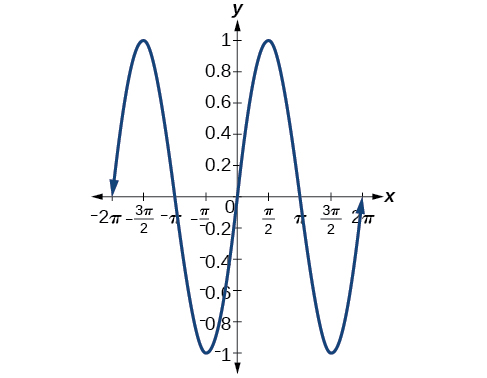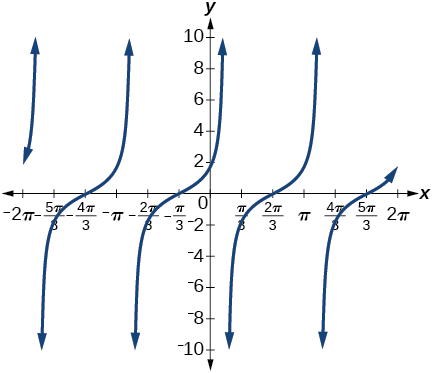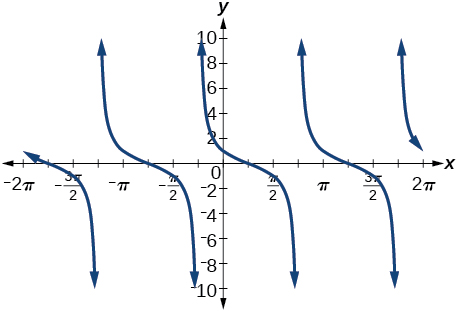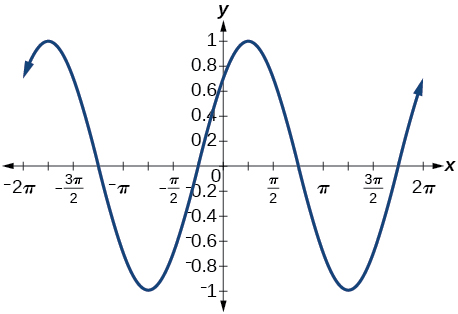7.2E: Exercises
( \newcommand{\kernel}{\mathrm{null}\,}\)
Verbal
1) Explain the basis for the cofunction identities and when they apply.
- Answer
-
The cofunction identities apply to complementary angles. Viewing the two acute angles of a right triangle, if one of those angles measures x the second angle measures π2−xThen sinx=cos(π2−x)The same holds for the other cofunction identities. The key is that the angles are complementary.
2) Is there only one way to evaluate \cos \left (\dfrac{5\pi }{4} \right )Explain how to set up the solution in two different ways, and then compute to make sure they give the same answer.
3) Explain to someone who has forgotten the even-odd properties of sinusoidal functions how the addition and subtraction formulas can determine this characteristic for f(x)=\sin (x) and g(x)=\cos (x)(Hint: 0-x=-x)
- Answer
-
\sin (-x)=-\sin x, so \sin x is odd. \cos (-x)=\cos (0-x)=\cos x, so \cos x is even.
Algebraic
For exercises 4-9, find the exact value.
4) \cos \left (\dfrac{7\pi }{12} \right)
5) \cos \left (\dfrac{\pi }{12} \right)
- Answer
-
\dfrac{\sqrt{2}+\sqrt{6}}{4}
6) \sin \left (\dfrac{5\pi }{12} \right)
7) \sin \left (\dfrac{11\pi }{12} \right)
- Answer
-
\dfrac{\sqrt{6}-\sqrt{2}}{4}
8) \tan \left (-\dfrac{\pi }{12} \right)
9) \tan \left (\dfrac{19\pi }{12} \right)
- Answer
-
-2-\sqrt{3}
For exercises 10-13, rewrite in terms of \sin x and \cos x
10) \sin \left (x+\dfrac{11\pi }{6} \right)
11) \sin \left (x-\dfrac{3\pi }{4} \right)
- Answer
-
-\dfrac{\sqrt{2}}{2}\sin x-\dfrac{\sqrt{2}}{2}\cos x
12) \cos \left (x-\dfrac{5\pi }{6} \right)
13) \cos \left (x+\dfrac{2\pi }{3} \right)
- Answer
-
-\dfrac{1}{2}\cos x-\dfrac{\sqrt{3}}{2}\sin x
For exercises 14-19, simplify the given expression.
14) \csc \left (\dfrac{\pi }{2}-t \right)
15) \sec \left (\dfrac{\pi }{2}-\theta \right)
- Answer
-
\csc \theta
16) \cot \left (\dfrac{\pi }{2}-x \right)
17) \tan \left (\dfrac{\pi }{2}-x \right)
- Answer
-
\cot x
18) \sin(2x)\cos(5x)-\sin(5x)\cos(2x)
19) \dfrac{\tan \left (\dfrac{3}{2}x \right)-\tan \left (\dfrac{7}{5}x \right)}{1+\tan \left (\dfrac{3}{2}x \right)\tan \left (\dfrac{7}{5}x \right)}
- Answer
-
\tan \left (\dfrac{x}{10} \right)
For exercises 20-21, find the requested information.
20) Given that \sin a=\dfrac{2}{3} and \cos b=-\dfrac{1}{4} with a and b both in the interval \left [ \dfrac{\pi }{2}, \pi \right ) find \sin (a+b) and \cos (a-b).
21) Given that \sin a=\dfrac{4}{5} and \cos b=\dfrac{1}{3} , with a and b both in the interval \left [ 0, \dfrac{\pi }{2} \right ) , find \sin (a-b) and \cos (a+b).
- Answer
-
\sin (a-b)=\left ( \dfrac{4}{5} \right )\left ( \dfrac{1}{3} \right )-\left ( \dfrac{3}{5} \right )\left ( \dfrac{2\sqrt{2}}{3} \right )=\dfrac{4-6\sqrt{2}}{15}
\cos (a+b)=\left ( \dfrac{3}{5} \right )\left ( \dfrac{1}{3} \right )-\left ( \dfrac{4}{5} \right )\left ( \dfrac{2\sqrt{2}}{3} \right )=\dfrac{3-8\sqrt{2}}{15}
For exercises 22-24, find the exact value of each expression.
22) \sin \left ( \cos^{-1}\left ( 0 \right )- \cos^{-1}\left ( \dfrac{1}{2} \right )\right )
23) \cos \left ( \cos^{-1}\left ( \dfrac{\sqrt{2}}{2} \right )+ \sin^{-1}\left ( \dfrac{\sqrt{3}}{2} \right )\right )
- Answer
-
\dfrac{\sqrt{2}-\sqrt{6}}{4}
24) \tan \left ( \sin^{-1}\left ( \dfrac{1}{2} \right )- \cos^{-1}\left ( \dfrac{1}{2} \right )\right )
Graphical
For exercises 25-32, simplify the expression, and then graph both expressions as functions to verify the graphs are identical.
25) \cos \left ( \dfrac{\pi }{2}-x \right )
- Answer
-
\sin x

26) \sin (\pi -x)
27) \tan \left ( \dfrac{\pi }{3}+x \right )
- Answer
-
\cot \left ( \dfrac{\pi }{6}-x \right )

28) \sin \left ( \dfrac{\pi }{3}+x \right )
29) \tan \left ( \dfrac{\pi }{4}-x \right )
- Answer
-
\cot \left ( \dfrac{\pi }{4}+x \right )

30) \cos \left ( \dfrac{7\pi }{6}+x \right )
31) \sin \left ( \dfrac{\pi }{4}+x \right )
- Answer
-
\dfrac{\sin x}{\sqrt{2}}+\dfrac{\cos x}{\sqrt{2}}

32) \cos \left ( \dfrac{5\pi }{4}+x \right )
For exercises 33-41, use a graph to determine whether the functions are the same or different. If they are the same, show why. If they are different, replace the second function with one that is identical to the first. (Hint: think 2x=x+x)
33) f(x)=\sin(4x)-\sin(3x)\cos x, g(x)=\sin x \cos(3x)
- Answer
-
They are the same.
34) f(x)=\cos(4x)+\sin x \sin(3x), g(x)=-\cos x \cos(3x)
35) f(x)=\sin(3x)\cos(6x), g(x)=-\sin(3x)\cos(6x)
- Answer
-
They are different, try g(x)=\sin(9x)-\cos(3x)\sin(6x)
36) f(x)=\sin(4x), g(x)=\sin(5x)\cos x-\cos(5x)\sin x
37) f(x)=\sin(2x), g(x)=2 \sin x \cos x
- Answer
-
They are the same.
38) f(\theta )=\cos(2\theta ), g(\theta )=\cos^2\theta -\sin^2\theta
39) f(\theta )=\tan(2\theta ), g(\theta )=\dfrac{\tan \theta }{1+\tan^2\theta }
- Answer
-
They are different, try g(\theta )=\dfrac{2\tan \theta }{1-\tan^2\theta }
40) f(x)=\sin(3x)\sin x, g(x)=\sin^2(2x)\cos^2x-\cos^2(2x)\sin2x
41) f(x)=\tan(-x), g(x)=\dfrac{\tan x-\tan(2x)}{1-\tan x \tan(2x)}
- Answer
-
They are different, try g(x)=\dfrac{\tan x-\tan(2x)}{1+\tan x \tan(2x)}
Technology
For the exercises 42-46, find the exact value algebraically, and then confirm the answer with a calculator to the fourth decimal point.
42) \sin (75^{\circ})
43) \sin (195^{\circ})
- Answer
-
-\dfrac{\sqrt{3}-1}{2\sqrt{2}}, or -0.2588
44) \cos (165^{\circ})
45) \cos (345^{\circ})
- Answer
-
\dfrac{1+\sqrt{3}}{2\sqrt{2}}, or -0.9659
46) \tan (-15^{\circ})
Extensions
For the exercises 47-51, prove the identities provided.
47) \tan \left ( x+\dfrac{\pi }{4} \right )=\dfrac{\tan x+1}{1-\tan x}
- Answer
-
\begin{align*} \tan \left ( x+\dfrac{\pi }{4} \right ) &= \\ \dfrac{\tan x + \tan\left (\tfrac{\pi}{4} \right )}{1-\tan x \tan\left (\tfrac{\pi}{4} \right )} &= \\ \dfrac{\tan x+1}{1-\tan x(1)} &= \dfrac{\tan x+1}{1-\tan x} \end{align*}
48) \dfrac{\tan (a+b)}{\tan (a-b)}=\dfrac{\sin a \cos a + \sin b \cos b}{\sin a \cos a - \sin b \cos b}
49) \dfrac{\cos (a+b)}{\cos a \cos b}=1-\tan a \tan b
- Answer
-
\begin{align*} \dfrac{\cos (a+b)}{\cos a \cos b} &= \\ \dfrac{\cos a \cos b}{\cos a \cos b}- \dfrac{\sin a \sin b}{\cos a \cos b} &= 1-\tan a \tan b \end{align*}
50) \cos(x+y)\cos(x-y)=\cos^2x-\sin^2y
51) \dfrac{\cos(x+h)-\cos(x)}{h}=\cos x\dfrac{\cos h-1}{h}-\sin x \dfrac{\sin h}{h}
- Answer
-
\begin{align*} \dfrac{\cos(x+h)-\cos(x)}{h} &= \\ \dfrac{\cos x\cosh - \sin x\sinh -\cos x}{h} &= \\ \dfrac{\cos x(\cosh-1) - \sin x(\sinh-1)}{h} &= \cos x\dfrac{\cos h-1}{h}-\sin x \dfrac{\sin h}{h} \end{align*}
For the exercises 52-, prove or disprove the statements.
52) \tan (u+v)=\dfrac{\tan u+\tan v}{1-\tan u \tan v}
53) \tan (u-v)=\dfrac{\tan u-\tan v}{1+\tan u \tan v}
- Answer
-
True
54) \dfrac{\tan (x+y)}{1+\tan x \tan x}=\dfrac{\tan x + \tan y}{1-\tan^2 x \tan^2 y}
55) If \alpha ,\beta and \gamma are angles in the same triangle, then prove or disprove
- Answer
-
True. Note that \sin (\alpha +\beta )=\sin (\pi -\gamma ) and expand the right hand side.
56) If \alpha ,\beta , and \gamma are angles in the same triangle, then prove or disprove \tan \alpha +\tan \beta +\tan \gamma =\tan \alpha \tan \beta \tan \gamma.

